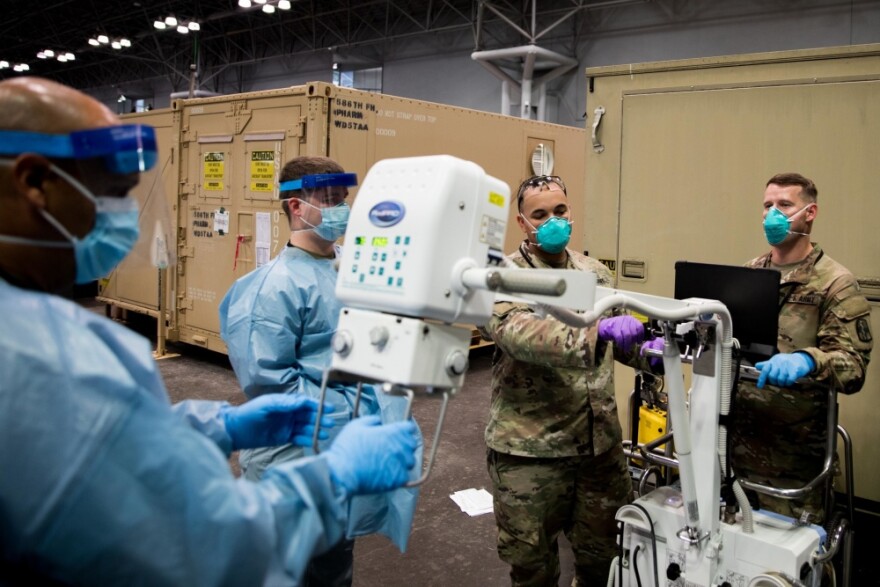The chief of U.S. Northern Command, Terrence O'Shaughnessy, is fighting an enemy that crept under his string of Arctic warning radars. The coronavirus spread quickly, killing thousands of people within weeks as most states across the country have ordered hundreds of millions of Americans to stay at home, many of them losing their jobs.
"It starts with the commander-in-chief and he's declared war on COVID-19 and that's exactly how we're treating it," O'Shaughnessy said.
The four-star Air Force general's war with the virus hasn't required fighter jets or armed forces, but rather hospital ships and military personnel. O'Shaughnessy's comments came Tuesday during a press conference with reporters held via Skype from Northern Command's headquarters on Peterson Air Force Base. He was clad in a camouflage uniform as virus case numbers and maps flashed on screens behind him.
Asked if he could predict when the war on the virus would be over, he could not say.
"What I do know, relative to the timelines, is that this is going to be a difficult time," he said. "It is unpredictable whether we're going to measure this in days, weeks, months, but what I do know is that we're going to be part of the response to our nation as long as they need us."
He added that the two weeks ahead are "going to be very difficult and very challenging."
"We see peaks in a couple of key areas, specifically in the northeast," he said. "We are starting to see indications of peaks in other cities and I think that's the pattern that we'll probably flow to is that we'll have individual peaks in different cities, different locales, that we'll have to address as this continues on for the next several months."
Stay-at-home measures, like those in Colorado and most other states, along with social distancing efforts, have made a "significant impact" in reducing the spread of the virus, O'Shaughnessy added.
Colorado Gov. Jared Polis said essentially the same thing in a rare address to the state earlier this week in which he extended stay-at-home orders until April 26. So far, Colorado health officials have tallied 179 deaths across the state, 1,079 hospitalizations and 44 outbreaks at residential and non-hospital health care facilities.
It was just three months ago that China reported its first coronavirus death. About 10 days later, the U.S. confirmed its first case, a man from Washington who had traveled to China's Wuhan region. Days later, China would implement a lockdown of its residents as cases there ballooned and the World Health Organization declared an international public health emergency. Soon after, U.S. military commanders around the world were told to be vigilant for any outbreaks and to report them.
In the ensuing weeks, Northern Command was called upon for help, at first assisting the Department of Health and Human Services with quarantining and treating hundreds of American travelers at military facilities around the country. As the virus spread, including the first case detected in Colorado in early March, Northern Command's role continued to grow, including aiding the Federal Emergency Management Agency as well as state and local governments.

The command oversaw the establishment of three Army field hospitals in the New York City and Seattle areas, along with readying FEMA staging and supply areas on the East and West Coasts. The command deployed to massive Navy hospital ships, including the USNS Comfort to New York City, where COVID-19-positive patients are being accepted aboard at what has been dubbed the pandemic's national epicenter. More than 1,000 medical personnel have also deployed to the region to help save lives.
O'Shaughnessy said the scope of the effort to fight the virus is unprecedented, but it hasn't impeded Northern Command's homeland security mission.
"We're maintaining our ability to defend our homeland," he said.
O'Shaughnessy wears a second hat as commander of NORAD, the North American Aerospace Defense Command, a binational alliance with Canada that defends against attacks, including any by foreign military aircraft. Several times last month, NORAD deployed U.S. and Canadian fighter jets to intercept Russian aircraft approaching the coast of Alaska. NORAD has a long history of escorting Russians nearing sovereign airspace spanning back to the decades of the Cold War. In recent years, intercepts have risen, U.S. military officials told KUNC.
Now, part of defending the homeland includes military personnel taking precautions as simple as wearing a mask or hand-washing to avoid coronavirus infection.
"Some of the things that we've had to do is separate our team from their family," the general said.
Some critical NORAD teams are following physical distancing to the extreme, he said. They're staying inside the nuclear-proof bunker inside a hollowed-out Cheyenne Mountain that overlooks Colorado Springs.







